Did Jefferson Invent Macaroni and Cheese? —
Rumor has it that Thomas Jefferson, the third president of the United States, could include, among his many other accomplishments, inventing macaroni and cheese (one of my favorite foods). The
wikipedia entry for mac and cheese mentions this rumor:
According to more than one urban legend, macaroni and cheese was invented by Thomas Jefferson, who, in the variant told by Alton Brown of Good Eats, upon failing to receive an Italian pasta-making machine, designed his own machine, made the macaroni, and had the cook put liberal quantities of York cheddar and bake it as a casserole.
I don't know how old this rumor is. I found references to it in newspapers from the 1990s, but not earlier. But needless to say, the rumor is incorrect. Jefferson does appear to have served macaroni and cheese at the White House, however he definitely didn't invent the dish.
Jack MacLaughlin sheds some light on Jefferson's relationship to Macaroni in his book
Jefferson and Monticello: the biography of a Builder:
Macaroni was a highly fashionable food in late eighteenth-century Paris, and Jefferson not only enjoyed the dish but also commissioned William Short to purchase a machine for making it. The machine was later shipped to America. Jefferson also investigated the manufacture of macaroni during his trip to northern Italy and drew a sketch with detailed notes on the extrusion process. When Short was in Italy, he sampled the local product and concluded that the cooks of Paris made better pasta than he could get at Naples. Apparently, the macaroni machine that Short bought was either not durable or unsatisfactory, for in later years Jefferson imported macaroni and Parmesan cheese from Marseilles for his use at Monticello. While in France, he also copied a recipe for making macaroni ("Nouilly a maccaroni") without a machine. This recipe makes clear that what was eaten as macaroni was what Americans today would term spaghetti — the dough was rolled thin and cut into strips, and each strip was then rolled with the hands into a noodle shape.
So it seems that Jefferson may have served pasta and cheese, but when he did the recipe was already in wide use in Europe. Marlena Spieler, author of
Macaroni and Cheese, writes that:
The first written recipe [for macaroni and cheese] seems to be from The Experienced English Housekeeper, by a Mrs. Elizabeth Raffald. Published in 1769, it appears to be the forerunner of our own American classic: bechamel sauce with Cheddar, mixed with macaroni, sprinkled with Parmesan, then baked until bubbly and golden. Another recipe, macaroni a la reine ("Macaroni in the style of the queen"), made from a similar mixture of pasta, cream, and melty cheese (often Gruyere), appeared frequently in British cookery books until relatively recent times.
So there you have it. No one knows exactly who invented mac and cheese, but it wasn't Jefferson, though he seems to have been a fan of it.

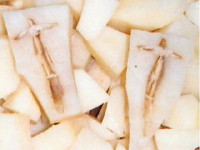 Renee Brewster of Florida found Jesus while preparing potato salad. His image was clearly visible in the moldy rot that had formed in the center of the first potato she split open. She put aside the holy potato and finished making the potato salad, which reportedly tasted excellent.
Renee Brewster of Florida found Jesus while preparing potato salad. His image was clearly visible in the moldy rot that had formed in the center of the first potato she split open. She put aside the holy potato and finished making the potato salad, which reportedly tasted excellent.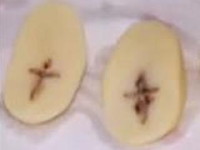 If one Jesus-in-a-potato isn't enough for you, then you're in luck, because the MyFoxOrlando article links to a second story, from just a few weeks ago, about a Houston woman who also discovered Jesus inside a potato. But I think the Florida Jesus-Potato is better.
If one Jesus-in-a-potato isn't enough for you, then you're in luck, because the MyFoxOrlando article links to a second story, from just a few weeks ago, about a Houston woman who also discovered Jesus inside a potato. But I think the Florida Jesus-Potato is better.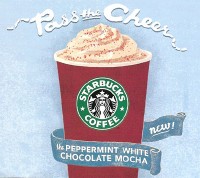 If you've been to Starbucks in the past week or so, you've been at risk of finding yourself trapped in a "cheer chain." What this means is that the person in line in front of you pays for your drink, and in return you're supposed to pay for the drink of the person behind you. This goes on and on, ad nauseam. The Associated Press reported on one cheer chain that totaled 1,013 customers.
If you've been to Starbucks in the past week or so, you've been at risk of finding yourself trapped in a "cheer chain." What this means is that the person in line in front of you pays for your drink, and in return you're supposed to pay for the drink of the person behind you. This goes on and on, ad nauseam. The Associated Press reported on one cheer chain that totaled 1,013 customers.


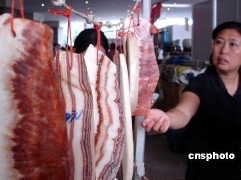
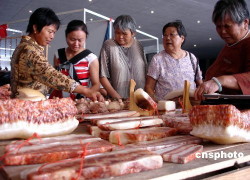
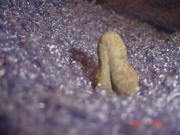
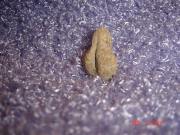
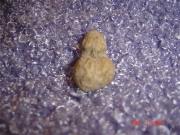
 China's food industry, already reeling from reports of toxins in pet food originating in China, took another blow when Beijing TV recently reported that snack vendors in eastern Beijing were selling "steamed dumplings stuffed with cardboard soaked in caustic soda and seasoned with pork flavoring." Yuck! In this case, however, the accusation appears to have been unwarranted. CNN reports that:
China's food industry, already reeling from reports of toxins in pet food originating in China, took another blow when Beijing TV recently reported that snack vendors in eastern Beijing were selling "steamed dumplings stuffed with cardboard soaked in caustic soda and seasoned with pork flavoring." Yuck! In this case, however, the accusation appears to have been unwarranted. CNN reports that:  Here's something to add to my list of Gross Things Found in Food. Philadelphia resident Earl Hartman was sitting down at home to enjoy some green beans and chicken, when he noticed something unusual in his beans.
Here's something to add to my list of Gross Things Found in Food. Philadelphia resident Earl Hartman was sitting down at home to enjoy some green beans and chicken, when he noticed something unusual in his beans.